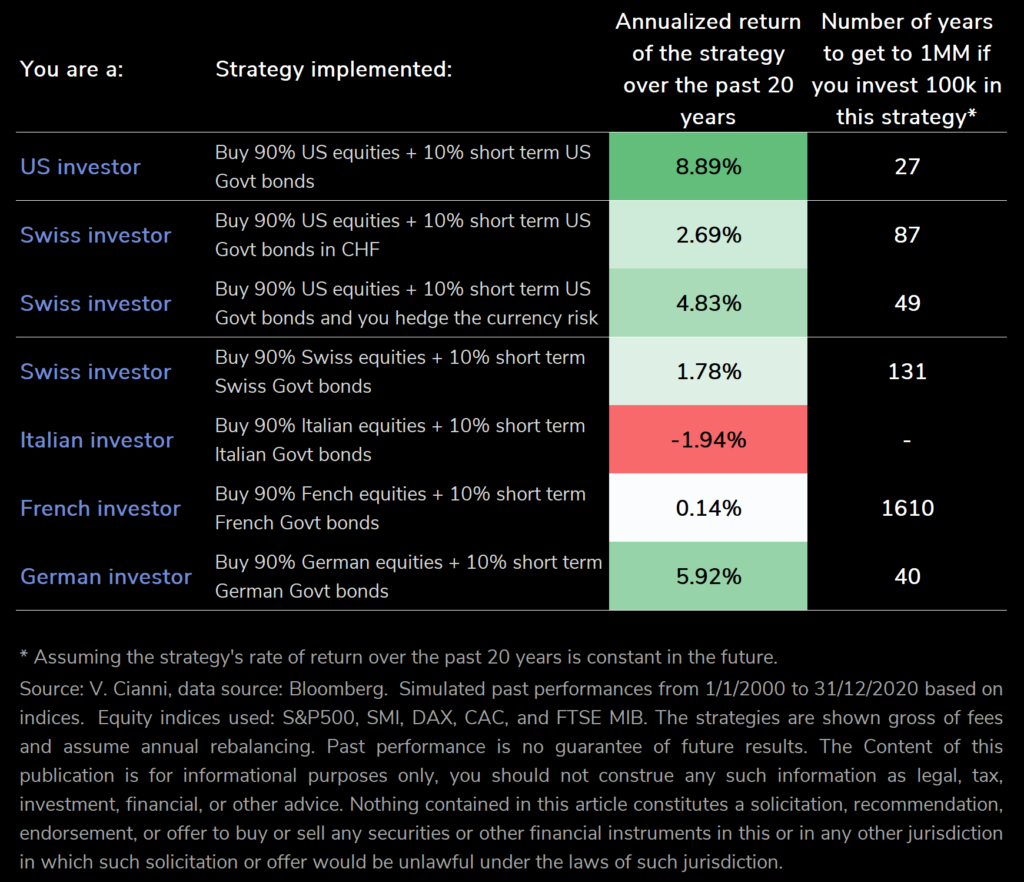Currency risks are not the only challenges investors face.
Warren Buffet had advice for fiduciaries and investors that was as simple as it was conclusive. In one of his letters to shareholders in 2013, he recommended the following strategy: put 10% of your money in short-term government bonds and 90% in a very low-cost S & P 500 index fund. It was a calculation that worked for many investors. But just not for all. This is because the context, i.e. the environment, is decisive for the success of investments. This includes currency risks as well as the specific situation in individual countries.
No recipe for success for all investors
Buffett’s word carries weight, and many financial blogs have called and are therefore calling on investors to follow his simple advice. But is this strategy really a recipe for success for everyone? Does it offer a model that achieves the hoped-for results, especially for Swiss or European investors?
What are the benefits of alternatives?
The fact is that anyone who is a resident of Switzerland or another European country has to weigh up some fundamental issues. When Swiss citizens buy U.S. stocks and bonds, they are taking on currency risk. In fact, they are buying U.S. dollar-denominated assets with CHF. But the Swiss franc has appreciated sharply in recent decades. So now you could go for an alternative: You adapt the strategy, but invest in local stocks and bonds. For example, as a Swiss investor, you can buy an ETF on the Swiss Market Index and short-term bonds from the Swiss government.
The test
But would this have worked and produced the same effects as Buffet’s original formula? The i-vest team put it to the test and developed a model calculation. It implies Buffet’s strategy, applied to investors in different countries and calculated for 20 years. One of the fundamental questions of the study was: How many years does it take for an amount of 100,000 euros, dollars, or CHF to become 1 million in the respective currency?

Significant differences
The result of the analysis is astounding: it proves that the context of the investment has a lasting impact on the result. The annualized return of the strategy over the last 20 years, therefore, shows significant differences.
Number 1 in the ranking
U.S. investors who consistently buy 90% U.S. equities + 10% short-term U.S. government bonds perform best. They reach the target of 1 million in about 27 years. This corresponds to an average annual return of 8.89%. The model calculation also shows a positive trend for German investors. If they were to invest 90% in German equities and 10% in short-term German government bonds, the target of 1 million euros would be reached after 40 years. The annual return would therefore be 5.92%.
Hedging currency risk
For Swiss investors, i-vest calculated three different models: The best result was achieved for investors if you buy 90% U.S. stocks + 10% short-term U.S. government bonds and hedge the currency risk when investing. The range to the target of 1 million CHF is 49 years, an annual return of 4.83%. Hedging the exchange rate risks is an essential factor. If this instrument is missing, the span until reaching the 1 million mark is extended to 87 years, the annual return drops to 2.69%. The result is even more unsatisfactory for investors who buy 90% Swiss equities and 10% short-term Swiss government bonds. In this case, the million would only be reached after 131 years, with an annual average return of 1.78%.
Poor France, poor Italy
The model calculation for French and Italian shareholders is disastrous: If you buy 90% French equities and 10% short-term French government bonds, it would take you 1,610 years to reach the bottom line of one million. The annual return is a meager 0.14%. Buying 90% Italian stocks and 10% short-term Italian government bonds is also not an option. The annual “return” is minus 1.94%. No need to predict when the million will be reached. Poor France, poor Italy!
Infobox:
The study assumed that with this strategy, the return – as in the last 20 years – will remain constant in the future (source: v. Cianni, data source: Bloomberg). Simulated past performance from Jan. 1, 2000, to Dec. 31, 2020, was based on indices. The following stock indices were used for this purpose: S&P500, SMI, DAX, CAC, and FTSE MIB.
The i-vest team expressly points out that this is a model calculation. Past performance is in no way a guarantee of future results. The content of this publication is for information purposes only.
Therefore, no conclusions or justifications in legal, tax, investment, financial or other matters can be derived from it. Information in this article should not be interpreted as a solicitation, recommendation, endorsement, or an offer to buy or sell any securities or other financial instruments in this or any other jurisdiction where such solicitation or offer would be unlawful under the laws of any jurisdiction.




